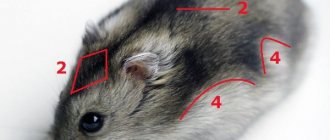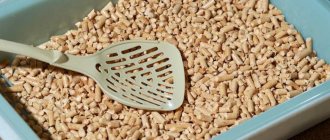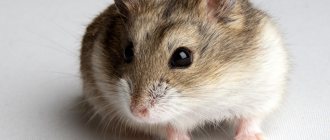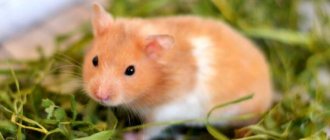Features of reproduction
Among the people, hamsters are known as very prolific animals, although this is only partly true. In captivity, hamsters actually breed all year round, but in the wild they obey instincts and reproduce only in the spring and summer. On average, a female gives birth 2–4 times per year, and the number of cubs in a litter varies greatly - from 1 to 18, but on average 8 animals are born in a litter.
The ability to reproduce offspring occurs already at the age of 1.5–2 months, although at such an early period pregnancy may not end successfully. It is optimal to mate a female from 4 months and a male from 3 months. In this case, the male can be used as a sire until the age of 10 months.
Did you know? Did you know? The most numerous offspring of a hamster is a litter of 26 cubs, which was produced by a hamster from the American Miller family in 1974.
Gestation lasts from 15 to 22 days and the very next day after the babies appear, the female hamster is physiologically ready for a new conception. Considering the life expectancy in captivity is up to 3, maximum 4 years, complications may occur during pregnancy already at the age of 1–1.5 years. It is known that nulliparous animals live longer than females that give birth.
Complications during childbirth
Toxicosis
A disease that occurs in the last days of pregnancy. Leads to the death of the female and brood during childbirth or in the first days after. There is no cure.
Pathology of childbirth
In females older than 10 months, the joints of the pelvic bones lose their elasticity, which is why the animal cannot give birth. Large fruiting is possible if there are few cubs (1-3 pieces). In such situations, strong contractions of the uterus cannot push the fetus out. If the female pushes for more than 10-15 minutes, and the baby does not appear, a caesarean section is necessary.
How long it takes hamsters to give birth depends on the number of children. The mother can rest for a long time between the birth of her babies, and even eat. There should be no unproductive fights.
Death of fetuses in the uterus
With infections, poor nutrition or genetic deformities, the cubs may die. The female is unable to give birth and dies from sepsis. Treatment is surgery to remove the uterus.
How do hamsters give birth?
Not every owner is able to witness the birth of their animal, since in most cases the birth of offspring occurs at night. Despite this, it is worth knowing the features and signs of the appearance of babies, as well as possible complications in the female and the procedure for action in such a situation.
Sure signs of approaching labor and its course
You can find out that your pregnancy is about to end by the following signs:
- the animal stops eating;
- activity decreases;
- the birth canal opens.
Important! If babies are born very quickly, the hamster may not have time to pierce the amniotic sac and then the baby will die. The female eats dead babies, as well as weakened ones and even some healthy ones. A similar phenomenon often occurs during the first pregnancy.
The birth of the brood itself occurs quite quickly.
Depending on the type of hamster, its size and the number of offspring, birth can last from 1 to 6 hours. Each baby appears at intervals of 2–3 minutes (in Syrian hamsters) or 15–30 minutes (in the Djungarian breed). During this period, the mother manages to gnaw the amniotic sac, gnaw the umbilical cord, eat the placenta and lick the baby. During birth, the hamster is in a sitting position, bending over its stomach. She herself helps babies to be born with her teeth.
What to do, how to help a hamster give birth
As such, human assistance is not required when giving birth to a hamster. The main task is to provide comfortable conditions for the expectant mother:
- 1-3 days before giving birth, you need to clean and wash the cage (it is better to use a one-story one for a pregnant female), replace the filler, and supply food that does not spoil.
- It is necessary to maintain an optimal temperature (21–24 °C) in the room and avoid drafts.
- It is advisable to place the cage with the expectant mother in a secluded, quiet, cozy place where nothing will disturb her.
- A pregnant or lactating female should not be frightened, picked up or touched again.
- It is strictly forbidden to keep a male and a female in the same cage, and not only during pregnancy and lactation, but at any time at all! Animals of different sexes should be placed in different cages immediately after mating.
Read about what a hamster cage should be like and how to properly equip it.
These are the main manipulations that you need to carry out before giving birth. If a female gives birth during the day in your presence, you can simply observe. However, if there are a lot of offspring and the female cannot cope, you can try to provide help: carefully wrap some of the babies in a paper napkin to remove mucus and amniotic sac, then cut the umbilical cord a little above the belly and return them back to the cage with the rest of the babies.
Under no circumstances should you interfere with the process if the female begins to eat the offspring after giving birth. The maximum that can be done in this situation is to provide her with protein food. Usually, after resting, the female begins to let the animals approach her nipples. If this does not happen, the cage should be placed in a dark place, covered, and, perhaps, within a short time the mother will begin to care for the offspring.
Possible complications
Complications can occur both during childbirth and after the birth of offspring:
- Toxicosis . Occurs in the last days before giving birth; the female and her brood may die during childbirth or shortly after. There is no therapy for this condition.
- Death of offspring in the womb. Occurs due to poor nutrition, infections, age, physiological characteristics or genetics. If surgery to remove the uterus is not performed, the female will soon die from blood poisoning.
- Prolonged labor. They arise due to age over 12 months (in females, over time, the pelvic bones lose elasticity), due to the large size of the cubs, especially if there are few of them in the brood. In this case, unproductive contractions occur - the fetus does not pass through the pelvic bones even with strong and numerous contractions. In this case, surgery is necessary.
- Mastitis . Disease of the mammary glands occurs soon after childbirth and leads to lack of lactation and inflammation.
- Endometritis. Inflammation of the uterus also occurs soon after childbirth, manifested by bloody, unpleasant-smelling discharge that lasts more than 3 days.
Important! In animals of the Dzungarian breed, complications during childbirth occur much more often, especially during interspecific crossing.
The reason is the large fruit in relation to the size of the female. In particularly severe cases, the female may die.
How long does pregnancy last in hamsters?
The gestation period depends not only on the type of hamster, but also on the number of cubs in the womb. Larger species of hamsters have a shorter gestation period. Also, the more fetuses, the earlier the birth will occur.
Gestation period for Syrian hamsters
The gestation period for Syrians is 16-20 days. The number of cubs is from 6 to 12, but there may be more.
Gestation periods in Djungarian hamsters
Among the Djungarians, pregnancy lasts a little longer than among the Syrians, 18-21 days. The number of cubs is from 4 to 8 pieces.
Other dwarf breeds of hamsters will have the same timing. The smaller the hamster, the longer the pregnancy lasts.
Caring for your hamster after giving birth
Like any new mother, a hamster needs special care and attention after all the hard work done. The most important thing you must do is to provide her with peace, quiet and good nutrition so that the pet can recover and properly care for the cubs.
Peace and quiet
If, before giving birth, you have properly prepared the place for the cage (a secluded, quiet, shaded corner), you should not change anything, let the relish with the offspring remain there for 2-3 weeks. At this time, you should not disturb your pet, try to pick up the hamsters, or disturb the animals in any way. This may be fraught with the refusal of the female to feed the cubs or even cannibalism. Other pets should not be able to approach the cage and disturb the hamsters.
We advise you to familiarize yourself with the breeding characteristics of Djungarian hamsters.
What to feed
During pregnancy, childbirth and feeding a brood, a hamster loses up to 1/3 of its weight, even if its diet is complete and balanced, because pregnancy for an animal is a rather energy-consuming and depleting process. At the same time, recovery is worse in older pets. Therefore, it is very important to support the female’s body with a balanced, varied diet.
The female may show interest in food already half an hour after the birth of the babies. During prolonged labor, when babies appear at large intervals (not to be confused with protracted, difficult labor!), the hamster can even rest and eat between the appearance of the animals. Feeding during the postpartum period differs from that of non-pregnant animals. Portions should be increased by 100%, protein content should not be lower than 20%, and fat content should not be lower than 10%. Along with grain mixtures, you should definitely include succulent foods from the list of permitted foods in your diet:
- greens (dill, parsley, lettuce, nettle and dandelion leaves)
- vegetables (zucchini, pumpkin, cucumbers and tomatoes, cabbage, etc.);
- fruits and berries (strawberries, raspberries, pears, apples, peaches and apricots, etc.).
Be sure to give a boiled egg, boiled chicken breast, and low-fat cottage cheese three times a week.
The female must have constant access to fresh drinking water. Find out what you should feed your hamster and whether you should give your hamster cabbage and bananas.
What to feed a pregnant hamster
The domestic hamster is quite picky about food, and a pregnant female, even more so, needs only the best food. The course of pregnancy largely depends on it: if the female ate well, then the baby is born healthy. The diet should include all possible nutritional components, vitamins and minerals. It is especially important that the diet is rich in protein and calcium, since they are involved in the formation of the fetus. Therefore, the daily menu must include:
- lean chicken or turkey meat (not raw or fried, but regular boiled meat without salt and spices);
- chicken eggs (whites only);
- fresh vegetables, preferably carrots, beets;
- cereals, sprouted seeds;
- fresh greens and grass.
When can you take hamsters away from their mother?
Hamsters are born absolutely helpless: they are blind, deaf, completely hairless and red; for minimal orientation in space and finding the mother, the babies have a slightly developed sense of smell. In general, they are completely dependent on their mother and are very vulnerable - little hamsters will not survive without their mother until they are 10 days old!
Some development features:
- on the 5th day the first fur appears;
- at the age of a week, babies begin to try solid food;
- on the 14th day the eyes begin to open;
- On days 20–21, lactation ends completely and the babies switch to independent feeding.
Did you know? At birth, the weight of a baby hamster does not exceed 2 g, and its size is only 10
–
15 mm!
Around this time, they can be taken from their mother and placed in separate cages. The maximum period until which animals can be kept together is 5 weeks. Keeping pets together for longer is very dangerous, since by nature they are loners and are very jealous of their territory.
Thus, the appearance of offspring in hamsters is a rather exciting, but extremely responsible process. You should not allow pets to reproduce at random, because pregnancy and childbirth are a difficult task for females. Therefore, the birth of small hamsters must be approached responsibly, the intervals between pregnancies must be observed, the female must be given the opportunity to fully recover and the most appropriately provided comfortable conditions for the pet so that the life of her and the babies is safe!
What to do when hamsters are born
Hamsters are born naked and are unable to thermoregulate.
It is necessary to provide the female with nesting material (paper towels) and maintain the house temperature in the range of 21-25 C.
Hamsters give birth to babies easily and quickly. No help is required, the owner can simply observe. But if a hamster has given birth to so many babies that she can’t cope, you can help her. The hamster is wrapped in a paper towel to remove membranes and mucus. Then they give a gentle massage. The umbilical cord is cut, stepping back a little from the tummy. The baby is placed in the nest, mixed with others.
If a Syrian hamster gives birth and immediately begins to destroy its brood, you cannot intervene . What to do in this case: by offering the hamster food rich in protein, you can save some of the babies.
After giving birth, you need to make sure that the female does not refuse to feed.
An exhausted hamster is allowed to rest for 4-6 hours. If she does not begin caring for the cubs, the mother is locked together with her brood in a small box so that she cannot escape. Most often, within half an hour, the female hamster allows the babies to approach the nipples.
Even a caring mother by the standards of hamsters does not stand on ceremony with her children. The animal lies directly on the brood, not caring not to crush the offspring.
We talked in great detail about the development and rules of caring for babies in an article about newborn hamsters. We highly recommend reading!
Results
As you can see, giving birth to a hamster is a process that requires a lot of responsibility and care on your part if you want all the newborns to survive. In order for your pet’s birth to be successful, you must carefully monitor the maintenance and nutrition of the pregnant hamster, protect the female from unnecessary stress, and if complications arise, immediately contact a specialist.
Did you like the article? Share with friends: [supsystic-social-sharing id=”1"]
- Related Posts
- Why do hamsters eat their babies?
- Newborn hamsters
- Hamsters mating
« Previous entry











